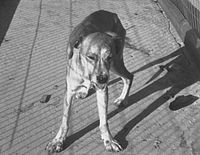
Photo from wikipedia
Background Biologically appropriate raw food (BARF) diet is becoming more and more popular among pet owners in Europe. However, there are documented microbiological risks associated with raw feeding, and this… Click to show full abstract
Background Biologically appropriate raw food (BARF) diet is becoming more and more popular among pet owners in Europe. However, there are documented microbiological risks associated with raw feeding, and this study aimed to determine the presence of human pathogens in commercially frozen BARF products sold in Italy. Methods Salmonella species, Escherichia coli O157:H7, Listeria monocytogenes and Campylobacter species were identified. The general microbiological quality of BARF products and hygiene were also evaluated. Sample size was limited and therefore the study may not be representative of a larger sample. Results None of the tested samples showed total bacterial count (TBC) higher than the limit set to consider a sample unacceptable. However, 14 out of 21 samples showed TBC higher than the limit set to consider a sample marginally acceptable. A high percentage of samples were contaminated by the aforementioned pathogens, highlighting the need for pet owners to be aware of the risks of this feeding strategy both to themselves and to their pets. Conclusions Considering that BARF diet meals can be prepared at home using the hands, as well as tools and spaces that could be shared, guidelines on safer handling of these pet food products should be recommended by veterinarians and nutritionists.
Journal Title: Veterinary Record
Year Published: 2020
Link to full text (if available)
Share on Social Media: Sign Up to like & get
recommendations!